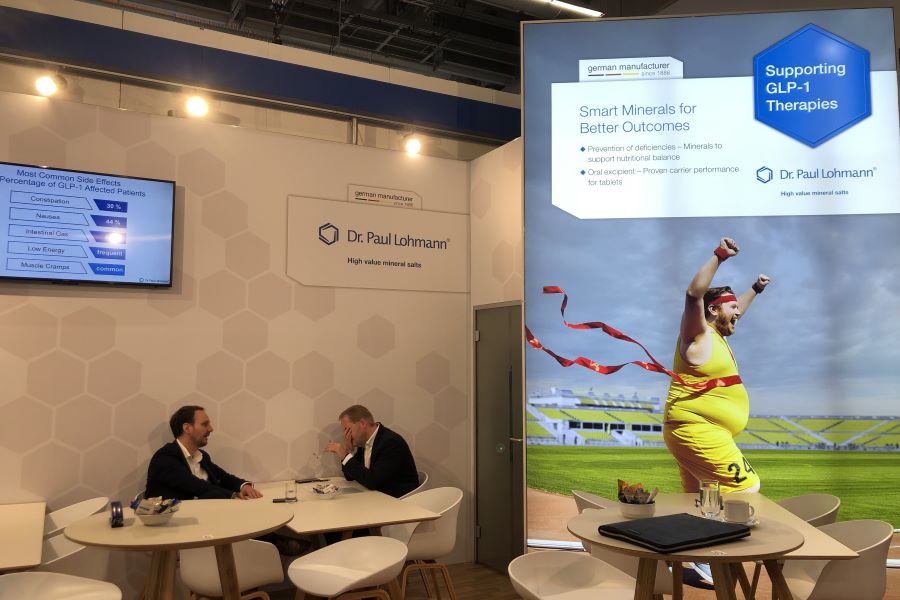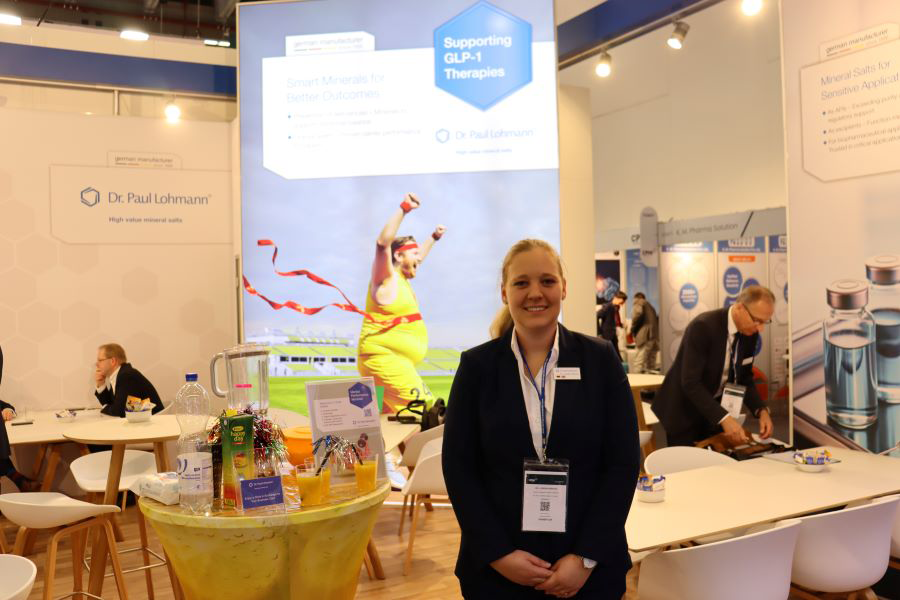CPHI 2025 live: Paul Lohmann spotlights magnesium bisglycinate and gut health launches
Key takeaways
- LomaChelateX Magnesium Bisglycinate provides high bioavailability and fewer gastrointestinal side effects, unlike mixed or non-reacted magnesium forms.
- The LomaChelateX line supports stable, gentle, and compatible formulations across capsules, powders, gels, and products for sensitive users, including GLP-1 patients.
- The company is developing a new range targeting gut health and the microbiome, with launches expected in early 2026.

Gentle gut care and supplement tolerability are in focus, reveals Paul Lohmann at the ongoing CPHI 2025 trade show (Oct 28–30). With rising sensitivity linked to therapies such as GLP-1, the company highlights its recently launched LomaChelateX Magnesium Bisglycinate, a high-bioavailability mineral that remains stable and gentle in complex formulations.
At the event in Frankfurt, Germany, Nutrition Insight speaks with Dr. Loreen Hericks, product manager of Pharma at Paul Lohmann, about the chemistry behind preserving magnesium bisglycinate’s bioavailability, current supplement market dynamics, and the company’s innovation roadmap.
How do you see magnesium bisglycinate fitting into the nutraceutical market’s shift toward more premium, high-bioavailability minerals?
Hericks: There are a lot of fake minerals on the market, where you don’t have real bisglycinates. Very often, it’s just a mixture of, for example, magnesium oxide with glycine. But our magnesium bisglycinate is a fully reacted compound. We introduced it as a product range and as a brand — LomaChelateX Magnesium Bisglycinate — in which the magnesium is stably bound by two glycine molecules.
These amino acids form a ring-like structure around the magnesium, creating a strong and stable chelate complex. This protects the magnesium during gastric passage, preventing early interactions and minimizing side effects in the gastrointestinal tract. Only in the small intestine is the chelate recognized and absorbed, allowing the mineral to enter the body efficiently.
This brings many advantages, such as fewer gastrointestinal side effects, significantly higher bioavailability, and enhanced chemical stability in complex formulations. It’s protected against inhibitors in the stomach and against anti-nutrients.
There’s also a new trend on the market called the “sleepy mocktail,” where you dissolve magnesium bisglycinate in cherry juice and drink it 30 to 60 minutes before sleep. Cherries have an effect on the melatonin release. Glycine has calming properties and can improve sleep quality, and the release of melatonin is higher with the sleepy mocktail. So you can get better and deeper sleep.
Formulation challenges are a prevalent issue with magnesium and minerals. How does the LomaChelateX line address them?
Hericks: Formulating with minerals like magnesium is often complex. The key challenges include low bioavailability — many traditional salts, such as magnesium oxides, are poorly absorbed. They also have lower digestive tolerance and can cause gastrointestinal side effects at higher doses.
There can also be formulation issues, where minerals interact with other ingredients, cause precipitation, or affect taste and texture in the finished product.
 Dr. Loreen Hericks, product manager for Pharma at Paul Lohmann.That’s where our LomaChelateX line makes the difference. These are fully reacted, true chelates. This ensures superior absorption and stability, so the magnesium remains protected during digestion. It’s very well tolerated and gentle on the stomach, even at higher concentrations.
Dr. Loreen Hericks, product manager for Pharma at Paul Lohmann.That’s where our LomaChelateX line makes the difference. These are fully reacted, true chelates. This ensures superior absorption and stability, so the magnesium remains protected during digestion. It’s very well tolerated and gentle on the stomach, even at higher concentrations.
We also see enhanced formulation compatibility — it has improved solubility, flowability, and a pleasant sensory profile across diverse applications. You can use it in capsules, powders, or instant drinks. We also have a newer formulation example where you can introduce it into gels, which is quite an innovative format, especially for elderly people who have trouble swallowing tablets. It’s easier to take in this semi-liquid form.
It’s suitable for sensitive target groups, such as pregnant women, who may have a more sensitive stomach. In dietary supplements and pharmaceutical applications, bisglycinates represent a modern, effective, and well-tolerated approach to mineral supplementation.
It’s also suitable for GLP-1 patients, since they may have sensitive digestion during therapy, making it a good alternative to less well-tolerated magnesium sources.
The product itself has been part of our range for some years, but we introduced it under the LomaChelateX brand at the end of September.
How might these minerals support people using GLP-1 medications?
Hericks: The use of GLP-1 medications is rising, and we’re seeing new nutritional challenges because these therapies can influence appetite, digestion, and nutrient absorption. That can lead to suboptimal mineral intake or deficiencies.
 A new trend is the “sleepy mocktail,” where magnesium bisglycinate is dissolved in cherry juice and consumed 30 to 60 minutes before sleep.When mineral levels drop, you can see typical side effects like muscle weakness or cramps — often linked to magnesium deficiency — bone and nerve issues related to calcium deficiency, and fatigue or low energy connected to iron deficiency.
A new trend is the “sleepy mocktail,” where magnesium bisglycinate is dissolved in cherry juice and consumed 30 to 60 minutes before sleep.When mineral levels drop, you can see typical side effects like muscle weakness or cramps — often linked to magnesium deficiency — bone and nerve issues related to calcium deficiency, and fatigue or low energy connected to iron deficiency.
It’s essential to ensure adequate mineral supply to maintain electrolyte balance, muscle and nerve function, and overall metabolic health.
Our high-quality mineral salts cover a broad range — iron, magnesium, calcium, zinc, and potassium — in several anion combinations such as bisglycinates and citrates. These play a vital role in addressing those needs.
For formulators, that means they have access to one reliable, physiologically effective source for multiple minerals that integrate seamlessly into supplements designed for individuals using GLP-1 therapies.
Furthermore, our service is very customized. We don’t just offer standard grades. Whenever our partners or customers face an issue with certain chemical or physical properties — say, bulk density or flowability — we work closely with them to adjust the parameters. Our R&D team supports these adjustments to ensure optimal performance in the final formulation.
Beyond deficiency prevention, what role can minerals play in GLP-1 therapies and their dosage forms?
Hericks: Minerals can serve not only as active ingredients but also as excipients in final formulations.
We have a sodium phosphate range that serves as buffering agents in GLP-1 injectable formulations. Their main function is to maintain a stable, physiologically compatible pH in the final dosage form.
 LomaChelateX line has enhanced formulation compatibility, such as adding it to gels for elderly people who have trouble swallowing tablets.We also see development toward oral dosage forms, such as tablets. Injectable pens are quite expensive, and tablets are more affordable. For that, we have excipients that fit well into those formulations. Customers can come to us, and we provide solutions tailored to their needs.
LomaChelateX line has enhanced formulation compatibility, such as adding it to gels for elderly people who have trouble swallowing tablets.We also see development toward oral dosage forms, such as tablets. Injectable pens are quite expensive, and tablets are more affordable. For that, we have excipients that fit well into those formulations. Customers can come to us, and we provide solutions tailored to their needs.
Looking at market and consumer trends, what innovation roadmap are you pursuing for mineral salts in nutraceuticals?
Hericks: We’ve seen that the microbiome and gut health are big topics. We’re working on innovations in this field to support a healthy gut microbiome. New product launches will come in January, and then we can share more about our innovations for gut health and the microbiome, within nutraceuticals
On specific minerals in demand now, I would say it’s really magnesium. It’s everywhere. Others, like iron, are important too, but we need iron only in small amounts. Magnesium is needed in larger amounts among the minerals, so it’s particularly relevant. In sports nutrition, for example, magnesium plays an important role in preventing muscle cramps. Magnesium has been in the spotlight for about one and a half to two years now.
Is there anything else you’re looking forward to at the show this year?
Hericks: In general, we’re highlighting our broad product range with a focus on our low-endotoxin quality. These grades can be used as active pharmaceutical ingredients or excipients and are important in biopharmaceutical processes. That’s a key focus for us this year, along with the GLP-1 topic, which was not as prominent last year.
The market focuses on proteins, but minerals are also important. When people eat less due to these therapies, they still need essential nutrients — from proteins and fatty acids to minerals. So this is a good opportunity for us.












